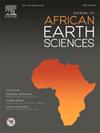利比亚西北部法尔瓦泻湖近代介形类和底栖有孔虫的分布
IF 2.2
4区 地球科学
Q2 GEOSCIENCES, MULTIDISCIPLINARY
引用次数: 0
摘要
本文首次详细研究了在利比亚西北海岸法尔瓦泻湖底部沉积物中发现的近期介形类和有孔虫组合。研究组合包括介形虫17属25种,有孔虫21属49种。这两类微生物的丰度和多样性因地点而异,为利用介形类和底栖有孔虫作为法尔瓦泻湖的生物指标提供了可能性。它们的分布受到许多湖泊条件的影响,包括盐度、沉积物类型、海草覆盖的存在、水动力以及污染源。一种常见的海洋物种Xestoleberis communis m本文章由计算机程序翻译,如有差异,请以英文原文为准。

Distribution of recent ostracods and benthic foraminifera from Farwa Lagoon (NW Libya)
This paper presents the first detailed study of recent ostracods and foraminiferal assemblages found in the bottom sediments of the Farwa Lagoon on the northwestern coast of Libya. The studied assemblages consist of 25 ostracod species belonging to 17 genera, and 49 foraminiferal species, belonging to 21 genera. The abundance and diversity of these two groups of microorganisms vary among sites, providing the possibility of using ostracods and benthic foraminifera as bio-indicators in the Farwa Lagoon. Their distributions are influenced by many limnological conditions, including salinity, sediment types, the presence of seagrass cover, and hydrodynamic forces, as well as by pollution sources. Xestoleberis communis Müller, a common marine species, is the source of >40% of the ostracod valves counted and is found at 12 of the 15 sites. Six other species account for ∼30% of the valves, including Cyprideis torosa (Jones), Aurila convexa (Baird), A. woodwardii (Brady), Pontocythere turbida (Müller), Celtia emaciata (Brady), and Loxoconcha rhomboidea (Fischer). Foraminiferal tests are more abundant as well as more species rich, with tests of Ammonia parkinsoniana (d'Orbigny) making up 13% of the assemblage and only four other species accounting for at least 5%, notably Elphidium crispum (Linnaeus), Peneroplis planatus (Fichtel and Moll), Ammonia beccarii (Linnaeus), Quinqueloculina seminulum (Linnaeus). The foraminiferal species can be categorized as free-living (e.g., Quinqueloculina), and epiphytic taxa (e.g., Peneroplis, Ammonia, Elphidium). The identified assemblages are widely distributed in the shallow marine environments along the Mediterranean coasts, such as Morocco, Tunisia, Egypt, Turkey, Spain and Italy.
求助全文
通过发布文献求助,成功后即可免费获取论文全文。
去求助
来源期刊

Journal of African Earth Sciences
地学-地球科学综合
CiteScore
4.70
自引率
4.30%
发文量
240
审稿时长
12 months
期刊介绍:
The Journal of African Earth Sciences sees itself as the prime geological journal for all aspects of the Earth Sciences about the African plate. Papers dealing with peripheral areas are welcome if they demonstrate a tight link with Africa.
The Journal publishes high quality, peer-reviewed scientific papers. It is devoted primarily to research papers but short communications relating to new developments of broad interest, reviews and book reviews will also be considered. Papers must have international appeal and should present work of more regional than local significance and dealing with well identified and justified scientific questions. Specialised technical papers, analytical or exploration reports must be avoided. Papers on applied geology should preferably be linked to such core disciplines and must be addressed to a more general geoscientific audience.
 求助内容:
求助内容: 应助结果提醒方式:
应助结果提醒方式:


